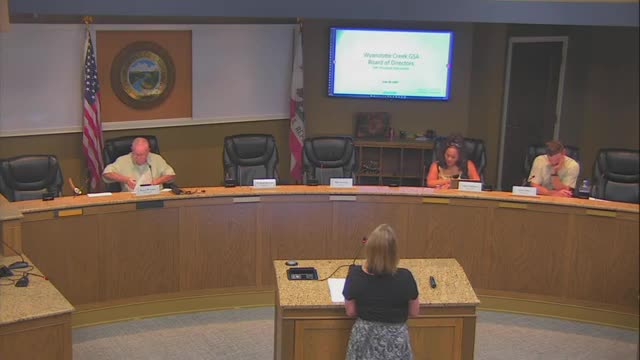Vina GSA Adopts New Proposition 26 Fee Structure for Wyandotte Creek Watershed
August 29, 2025 | Oroville, Butte County, California
This article was created by AI summarizing key points discussed. AI makes mistakes, so for full details and context, please refer to the video of the full meeting. Please report any errors so we can fix them. Report an error »

The Wyandotte Creek Groundwater Sustainability Agency (GSA) convened on August 28, 2025, to discuss significant developments regarding its fee structure, particularly in light of recent changes made by the Vina GSA. The meeting highlighted the importance of adapting funding mechanisms to meet regulatory requirements and support sustainable groundwater management in the region.
A key focus of the meeting was a presentation by Catherine, who was contracted to analyze the Vina GSA's fee structure and its applicability to the Wyandotte Creek subbasin. This analysis comes after the Vina GSA adopted a new fee structure in June, transitioning from a Proposition 218 fee to a Proposition 26 regulatory fee. This shift is noteworthy as it reflects a broader trend among groundwater sustainability agencies in California, moving towards regulatory fees that fund compliance with state mandates rather than management activities.
Catherine explained the distinctions between the two types of fees. Proposition 218 fees require a public protest process and are typically used for management activities such as land acquisition and project development. In contrast, Proposition 26 fees can be adopted without a protest process and are designated for regulatory activities, including reporting to the Department of Water Resources and conducting necessary studies.
The meeting underscored the importance of stakeholder engagement in developing the fee structure. Catherine noted that the Vina GSA's fee was shaped by extensive stakeholder input, surveys, and legal counsel, resulting in a two-part fee structure aimed at ensuring compliance with state regulations while addressing the financial needs of the GSA.
As the Wyandotte Creek GSA considers adopting a similar fee structure, the discussions from this meeting will likely influence future decisions regarding funding and regulatory compliance. The agency's ability to adapt its financial strategies will be crucial in managing groundwater resources effectively and sustainably in the face of ongoing environmental challenges. The next steps will involve further analysis and potential stakeholder engagement to finalize any changes to the fee structure.
A key focus of the meeting was a presentation by Catherine, who was contracted to analyze the Vina GSA's fee structure and its applicability to the Wyandotte Creek subbasin. This analysis comes after the Vina GSA adopted a new fee structure in June, transitioning from a Proposition 218 fee to a Proposition 26 regulatory fee. This shift is noteworthy as it reflects a broader trend among groundwater sustainability agencies in California, moving towards regulatory fees that fund compliance with state mandates rather than management activities.
Catherine explained the distinctions between the two types of fees. Proposition 218 fees require a public protest process and are typically used for management activities such as land acquisition and project development. In contrast, Proposition 26 fees can be adopted without a protest process and are designated for regulatory activities, including reporting to the Department of Water Resources and conducting necessary studies.
The meeting underscored the importance of stakeholder engagement in developing the fee structure. Catherine noted that the Vina GSA's fee was shaped by extensive stakeholder input, surveys, and legal counsel, resulting in a two-part fee structure aimed at ensuring compliance with state regulations while addressing the financial needs of the GSA.
As the Wyandotte Creek GSA considers adopting a similar fee structure, the discussions from this meeting will likely influence future decisions regarding funding and regulatory compliance. The agency's ability to adapt its financial strategies will be crucial in managing groundwater resources effectively and sustainably in the face of ongoing environmental challenges. The next steps will involve further analysis and potential stakeholder engagement to finalize any changes to the fee structure.
View full meeting
This article is based on a recent meeting—watch the full video and explore the complete transcript for deeper insights into the discussion.
View full meeting
